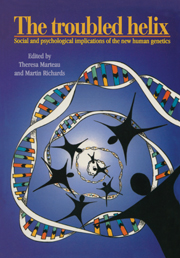Book contents
- Frontmatter
- Contents
- List of contributors
- Preface
- Preface to the paperback edition
- Acknowledgements
- Part I Personal stories
- Part II Clinical context
- Part III Social context
- 9 The troubled helix: legal aspects of the new genetics
- 10 Human pedigree and the ‘best stock’: from eugenics to genetics?
- 11 Public understanding of the new genetics
- 12 Families, kinship and genetics
- 13 Ethics of human genome analysis: some virtues and vices
- 14 Genetics and racism
- 15 Predictive genetics: the cultural implications of supplying probable futures
- 16 The new genetics: a feminist view
- 17 Afterword
- Index
12 - Families, kinship and genetics
from Part III - Social context
Published online by Cambridge University Press: 01 June 2011
- Frontmatter
- Contents
- List of contributors
- Preface
- Preface to the paperback edition
- Acknowledgements
- Part I Personal stories
- Part II Clinical context
- Part III Social context
- 9 The troubled helix: legal aspects of the new genetics
- 10 Human pedigree and the ‘best stock’: from eugenics to genetics?
- 11 Public understanding of the new genetics
- 12 Families, kinship and genetics
- 13 Ethics of human genome analysis: some virtues and vices
- 14 Genetics and racism
- 15 Predictive genetics: the cultural implications of supplying probable futures
- 16 The new genetics: a feminist view
- 17 Afterword
- Index
Summary
I am the family face;
Flesh perishes, I live on,
Projecting trait and trace
Through time to times anon,
And leaping from place to place
Over oblivion.
Thomas Hardy, 1840–1928: Heredity.Introduction
Genetics concerns families and kinship. It is the study of the ways in which heritable characteristics and conditions are passed from parents to children through the generations. As the new genetics develops, the possibilities of describing the gene mutations that an individual may carry and may pass to children are increasing dramatically. This new knowledge and the ways in which it is employed may have profound consequences for family life and relationships.
The public's knowledge and beliefs about inheritance have not arisen de novo with the coming of the new genetics, or even with Mendelian genetics at the turn of the century: they have long been part of family culture. Much family talk is about particular characteristics of family members, who these may have been acquired from, and who they may be passed to. Witnessing family members greet a new baby demonstrates the important process of ‘placing’ the new baby in terms of characteristics shared with forebears. Increasingly, we have photographs and other visual evidence of the appearance of our forebears and we use these to point to similarities and differences. In my own family I am said to get my nose from my mother's family but have a temperament more like some of my father's male relatives.
- Type
- Chapter
- Information
- The Troubled HelixSocial and Psychological Implications of the New Human Genetics, pp. 249 - 273Publisher: Cambridge University PressPrint publication year: 1996
- 74
- Cited by

